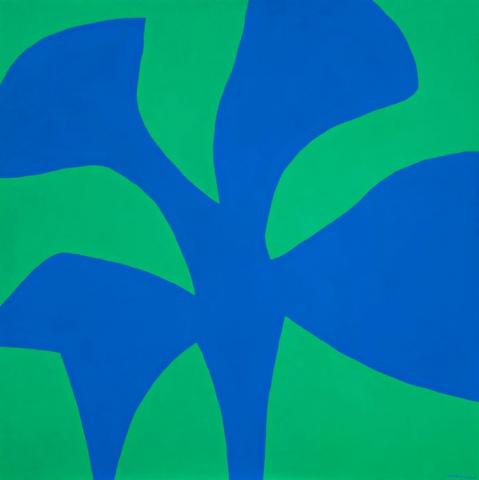RAINFOREST I, 1968
John Coburn
synthetic polymer paint on canvas
153.0 x 153.0 cm
signed lower right: Coburn
Christie's, Melbourne, 27 November 2000, lot 106, as 'Untitled'
Private collection, Melbourne
Klepac, L., John Coburn: The Spirit of Colour, The Beagle Press, Sydney, 2003, p. 77 (illus.) as 'Untitled'
Ace I, 1966, oil on canvas, 152.0 x 152.0 cm, Ace II, 1966, oil on canvas, 152.0 x 152.0 cm, Art Gallery of South Australia
Rainforest 1968, synthetic polymer paint on canvas, 172.0 x 233.7 cm, Museum of Contemporary Art, Sydney
Rainforest I is a classic example of John Coburn's hard-edged colour field painting of the late sixties. A complementary work, Rainforest, 1968, is in the collection of the Museum of Contemporary Art, Sydney: that work is the reverse of this painting where blue dominates the green field. Part of the appeal of these paintings lies in the artist's audacity to limit his palette to two colours, giving them the resonance only a master colourist can achieve. Striking in its minimalism, Coburn gave his images the hardest of edges, the sinuous forms moving from the geometric into the biomorphic. The antecedents of Rainforest include Tree of Life, 1965 (Art Gallery of New South Wales) and Primordial Garden, 1965-66 (National Gallery of Victoria), these blue-green paintings having their inspiration in Coburn's recollection of the luscious colours of his mother's garden in tropical north Queensland.
Two streams, however, converge in this painting, continuing imagery and ideas introduced in two paintings from 1966, Ace I and Ace II, the latter being in the collection of the Art Gallery of South Australia. All are square in format, the same in size, and with colour field and form again alternating in their dominance. This is characteristic of Coburn's best work, allowing the interchange of the superimposed and the background with great visual effect.
In both Ace I and Ace II, painted in dazzling colours, the dominant emblematic or heraldic motifs interchange with their fields, the optical effect being as striking as in Rainforest I. Moreover, all these flat areas of paint express a distinctly celebratory mood. The red in the first two works pulsates, the blue, while being more complementary in the colour scale, also sets up visual vibrations which give our painting so much of its vivacity. Coburn's colours sing, their sonorous qualities expressing a celebratory feeling confirmed by their titles such as Canticle of the Sun, 1965 (formerly in the Mertz Collection), the 1974 Aubusson tapestry Fanfare, and the painting 1977 Hozanna I.
For Coburn the middle years of the sixties were a vintage time. His 1966 exhibition at Kym Bonython's Hungry Horse Gallery in Paddington was a sell-out. The same year he began designing tapestries, becoming a leader in the field, some of his finest tapestries being the Sydney Opera House curtains and the Creation series in Washington D.C.'s John F. Kennedy Performing Arts Centre. A highly individual artist, Coburn nevertheless responded to the ideas and movements of his time, Rainforest I, 1968, being painted in the same year as that celebrated contemporary exhibition The Field, an inaugural show for the then new National Gallery of Victoria when it opened on St Kilda Road.
DAVID THOMAS
